INTRODUCTION
Weeds are widespread across Nevada, with 45 plant species legally designated as “noxious weeds” by the Nevada Department of Agriculture. Noxious weeds are species considered detrimental or destructive, and difficult to control or eradicate. In Nevada, noxious weeds are prohibited in commerce, and state law mandates their control or management. Landowners are responsible for controlling weeds on their property.
Paradise Valley is a large agricultural area in Humboldt County. The valley winters about 10,000 or more beef cows every year and produces grass hay and/or alfalfa hay on about 40,000 acres. This hay is used largely for local consumption, but some is exported to other cattle producing areas. The meadows, riparian areas, and brush fields in the valley provide habitat for many species of wildlife, including mule deer, pheasants, wild turkeys, ducks, geese, doves, shorebirds, small mammals, and several predator species (e.g., mountain lion and bobcat). The agricultural fields and adjacent wildlands provide both year-long and seasonal habitat.
In addition to being an agricultural center, Paradise Valley is surrounded by public land administered by the Bureau of Land Management and the United States Forest Service. These lands have many valuable resources that support wildlife, recreation, livestock production, and other land uses. All public lands, but particularly the meadows and riparian areas, provide critical habitat for many wildlife species, including sage grouse, mule deer and pronghorn antelope. These lands are susceptible to invasion by at least one, and probably most of the noxious weed species that inhabit Paradise Valley.
Noxious weeds have been a problem in Paradise Valley since the 1940’s. The Paradise Valley Weed Control District (PVWCD) was formed in the late 1940’s to address an increase in hoary cress or short whitetop (Cardaria draba). Since creation of the PVWCD, the scale of weed control efforts in Paradise Valley has varied widely over time. Since 2002, control efforts have expanded substantially for several reasons; including, the appointment of a permanent coordinator, the initiation of regular interaction with the University of Nevada Cooperative Extension and development of a comprehensive weed management plan. These developments occurred because hoary cress still is not under control, and numerous other weed species with significant ecological impact have become widespread. These species are Canada thistle (Cirsium arvense), leafy spurge (Euphorbia esula), mayweed chamomile (Anthemis cotula), musk thistle (Carduus nutans), medusahead (Taeniatherum caput-medusae), perennial pepperweed (Lepidium latifolium), poison hemlock (Conium maculatum), Russian knapweed (Acroptilon repens), salt cedar (Tamarix ramosissima), Scotch thistle (Onopordum acanthium), and water hemlock (Cicuta maculata). Each species covers an area from tens of acres to several thousand acres in and/or near the PVWCD.
The weed management plan developed by the PVWCD acknowledges the need to develop a large-scale, focused treatment program to: 1) prevent the loss of additional acreage to noxious weeds; and 2) prevent the establishment of additional noxious weed species. Long-term success for weed control in the PVWCD, as well as all of Nevada, will require that all residents believe noxious weeds can be effectively controlled. Control is defined as the reduction of weed populations to a manageable level with minimal subsequent economic impact, and very few, if any, new infestations becoming established.
Many landowners are hesitant to spend money and/or time for chemical control of noxious weeds. They are unsure about the effectiveness of existing herbicides, many of which are expensive. Also, many individuals lack knowledge about when (i.e., timing) specific herbicide applications should occur, and/or the availability of new chemicals. Finally, treatment often does not occur because the window of opportunity for effective control of some species is short, and other time critical tasks are a higher priority.
Since 2003, the Humboldt County office of the University of Nevada Cooperative Extension, in cooperation with the PVWCD, has established a series of demonstration plots to increase local awareness and knowledge about the control of four noxious weed species: hoary cress (plots established in 2003), leafy spurge (plots established in 2003 and 2004), Russian knapweed (plot established in the fall of 2004), and perennial pepperweed (plots established in 2005). Each demonstration plot (or group of plots) was developed to address one or more of the following issues: 1) management of a weed the PVWCD had previously put little effort toward; 2) a recently released herbicide with no history of local use; and/or 3) an alternative time of the year for treatment. This publication addresses the use of Plateau® (imazapic) on hoary cress at two growth stages. One growth stage was at or shortly after the period of peak flowering, and the other was fall regrowth. Other publications will address the use of Plateau® and Tordon®22K (picloram) for leafy spurge and Plateau® for Russian knapweed.
THE TARGET SPECIES
Hoary cress is a relatively long-lived perennial forb (non-woody flowering plant) that spreads by creeping roots and seed. Seed germinates in the fall or spring, and plant growth begins with development of a vertical tap root, which develops one or more lateral roots. The lateral roots typically produce new rosettes and flowering shoots. The first lateral roots eventually turn downward to become secondary vertical roots, often reaching depths of 30 to 60 inches. Roots from individual plants have been traced as deep as 18.5 feet and can spread laterally an average of 4-5 feet per year. Buds are found on every inch of all roots and each bud can develop a new plant. Maximum carbon storage in the roots (i.e., translocation from leaf to roots) is completed by the end of the flowering period. Flowering typically occurs in late spring to early summer (May-June), but can be earlier in dry or warm years. Seed production is high (thousands per plant), and some seed remains viable for up to three years.
The general recommendation for chemical treatment of hoary cress has been the application of Escort® (metsulfuron) or Telar® (chlorsulfuron) during the pre-bloom growth stage in the spring or to basal rosettes in the fall, if they are present. Hoary cress begins growth in early to mid spring and blooms in late spring to early summer. This results in a short period (several weeks to a month) between the basal rosette growth stage and full bloom. This presents a narrow window of opportunity for control with herbicides. Fall treatment is opportunistic, depending whether or not soil moisture is adequate to promote regrowth.
METHODS
Two case studies were implemented. The first addressed the use of Plateau® at or shortly after peak flowering, to determine the possibility of extending the treatment window for hoary cress from pre-flowering to postflowering. Plateau® was applied to three oneacre plots on June 9, 2003. On a per acre basis, the spray mix included 8 oz. of Plateau® (2 oz. of active ingredient/acre), one quart of methylated seed oil (MSO) as a surfactant, and 20 gallons of water. The chemical mix was delivered using an ATV mounted boom sprayer, in the morning and early afternoon, of a sunny day with little to no wind. The growth stage of the plants treated ranged from peak flowering to slightly after peak flowering. All plots were located in a pasture that receives irregular supplemental irrigation during wet years, and only after senior water rights are satisfied. At the time of application, none of the study plots had been irrigated for several years due to drought. Of the three treatment plots, plots 1 and 3 are located on areas slightly depressed, compared to plot 2. This microtopograhic feature permitted some subirrigation from shallow groundwater on plots 1 and 3. The soil on plot 3 had the highest visible water content, followed by plot 1. The soil in plot 2 was visibly drier at the time of herbicide application, and the plants were very desiccated compared to plants on plots 1 or 3.
The second case study occurred in a non-replicated plot where the primary focus was the fall treatment of Russian knapweed with Plateau®. This plot had a large and widespread population of hoary cress rosettes that emerged after fall precipitation; therefore, it provided the opportunity to observe the effect of treating hoary cress’s fall regrowth with Plateau®.
The herbicide mix was applied on October 25, 2004, well after the first freeze. The chemical mix, on a per acre basis, consisted of 12 oz of Plateau® (3 oz. of active ingredient/acre), one quart of methylated seed oil, and 20 gallons of water. The amount of Plateau® applied was the labeled rate for Russian knapweed (also the maximum allowable rate per acre in one year), which is slightly higher than the low end of the recommended rate for hoary cress (8-12 oz. of product/acre). The hoary cress plants were in the basal rosette growth stage (i.e., preflowering). Leaves were at least several inches long. Plateau® is recommended for use from full bloom to desiccation. This treatment tested the efficacy of Plateau® for fall treatment at the rosette growth stage. This study site was in a field that had not been irrigated for at least three years and had a depleted stand of desired perennial grasses. Weather during the mid-afternoon application was cool (about 45-50°F) and windy. Light snow had fallen that morning but had melted by late morning. Application was with a tractor mounted boom sprayer. The plot was re-photographed on June 28, 2005.
Hoary cress populations on all treatment plots were too patchy to use sampling quadrats to document the success or failure of each treatment. Prior to treatment, too many of the randomly placed quadrats had either many plants present or none. While undesirable from a purely experimental approach, the density and cover of the hoary cress populations were typical of the amount of weeds encountered by most landowners. The effect of the treatments was recorded with photographs taken at the time of treatment and near the end of the following growing season (i.e., mid to late June). The photos were aligned to show boundaries between treated and untreated areas.
RESULTS
Case Study 1 – Plateau® at Peak Flowering
Figures 1a and 2a show plots 1 and 2 at the time of treatment. Hoary cress plants in each plot are flowering, but the plants in plot 1 are greener, and presumably have more active growth. Figures 1b and 2b show the same sites one year after treatment. Plot 1 has very distinct lines on the north (distant), east (right), and south (fore-front) borders that clearly identify the boundary between the treated and non-treated areas. On plot 1 there are substantially fewer hoary cress plants in the treated area, and there are dense clumps of hoary cress outside the treated area. Figures 2a and 2b indicate the treatment in plot 2 was much less successful than in plot 1. The elevation of plot 2 is slightly above plot 1, and this slightly higher elevation appeared to result in plot 2 receiving substantially less (if any) sub-irrigation. The hoary cress plants in plot 2 had very evident signs of moderate to severe desiccation.
Figure 3 shows plot 3 one year after treatment, and the treated area is very evident. Very clear growth patterns of hoary cress identify the eastern and southern boundaries of the plot. Dense clumps of hoary cress are evident just outside the treated area, but very few flowering plants are inside the treated area.
Figure 4 shows an area treated in an effort to empty the ATV mounted spray unit. The treated area is clearly shown by the absence of flowering plants of hoary cress. One year after treatment, virtually no flowering plants are present in the treated area but dense clumps are common in the untreated areas on all sides of the plot.
In addition to taking photos of each area treated, each site was visually searched for plants that had not yet flowered. Nonflowering individuals of hoary cress were virtually absent in each treatment plot, except plot 2. This indicates that the fall treatment with Plateau® resulted in high mortality, not a delay of growth, which would have resulted in flowering after the photos were obtained.
Case Study 2 – Application of Plateau® to Fall Regrowth
Figure 5a shows the western boundary of the treatment plot at the time of treatment, and Figure 5c plant growth the following June. Chemical coverage was excellent, especially on hoary cress not located under the desiccated over story of Russian knapweed. Abundant bare ground also resulted in substantial amounts of chemical being placed on the soil surface.
Regrowth on the treated plot was virtually absent in late June 2005 (Figure 5c). The short green plants in the right side of Figure 5c are hoary cress. The taller green plants are Russian knapweed. There are virtually no hoary cress plants in the treated area.
DISCUSSION
Plateau® provided effective control of hoary cress on most treatment plots. In Case Study 1, excellent control was visually evident one year after treatment in three of the four treated areas (Figures 1a-4). Treatment plots with good control of hoary cress had green plants and sufficient soil moisture for additional plant growth immediately after application of Plateau®. Active growth should have resulted in good uptake of the herbicide that landed on the leaves. Figures 2a and 2b show a site with very dry soil and desiccated plants. Active growth from these plants after the herbicide was applied was unlikely to occur; therefore, uptake of the herbicide by the plant from its leaves would have been very low or absent. Application of Plateau® to desiccated plants of hoary cress in late spring or early summer appears to have no effect on the target species. Plateau® appears to be very effective one year after treatment at peak flowering, provided there is sufficient soil moisture for active growth to occur after the herbicide is applied. Plateau® appears to extend the period of successful treatment of hoary cress to the peak flowering growth stage, which is at least several weeks beyond the narrow window provided with Escort® (metsulfuron).
Figure 1a. Hoary cress treatment plot 1 on June 4, 2003, when Plateau® was applied. The small white flowers in the lower right are hoary cress plants. Hoary cress is present to the left of the tape measure, but either has not flowered or cannot be seen due to the presence of taller vegetation.
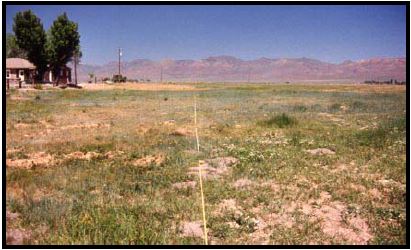
Figure 1b. The same area shown in Figure 1a on June 9, 2004, one year after treatment. There is very little flowering or nonflowering hoary cress inside the treated area (defined by the white lines). Flowering plants of hoary cress are common outside the treatment plot. The availability of irrigation water in 2004 has permitted good growth of the vegetation. If hoary cress had survived the application of Plateau® it should have had good growth.
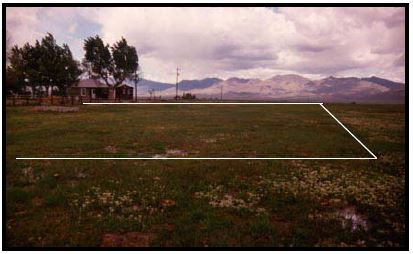
Figure 2a. Hoary cress treatment plot 2 at the time of treatment on June 9, 2003. The soil is very dry and the vegetation very desiccated compared to Figure 1a. The two plots are within 100 feet of one another, but the area depicted in Figure 2a is about 12 to 18 inches higher in elevation and receives little, if any, sub-irrigation, particularly in dry years (i.e., 2003).
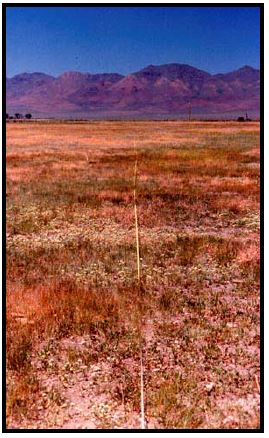
Figure 2b. The area between the lines is the same area shown in Figure 2a, but on June 4, 2004, one year after treatment. Hoary cress plants are abundant both pre- and post-treatment. The availability of irrigation water in 2004 has allowed the vegetation to have better growth for a longer period than in 2003.
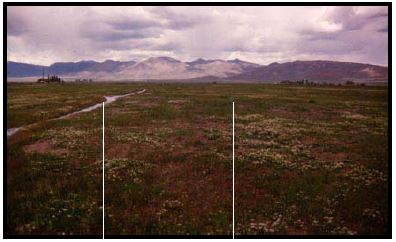
Figure 3. Hoary cress treatment plot 3 on June 4, 2004, one year after the application of Plateau® (a pre-treatment photo is unavailable). The treated area (inside the white lines) is largely devoid of hoary cress. The white flowering plants outside the white lines show the abundance of hoary cress in the untreated area. This area received limited irrigation from runoff on an adjacent landowner’s property and some subirrigation in 2003. Plant growth at the time of herbicide application was similar to that in Figure 1a.
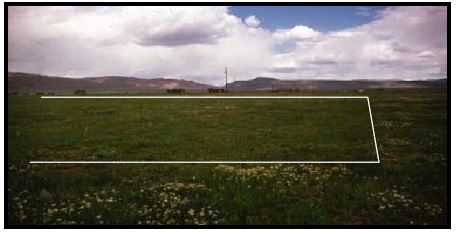
Figure 4. The area inside the white lines was treated with Plateau® on June 9, 2003. This photo shows plant growth on June 4, 2004. Both flowering and non-flowering hoary cress are virtually absent in the treated area.
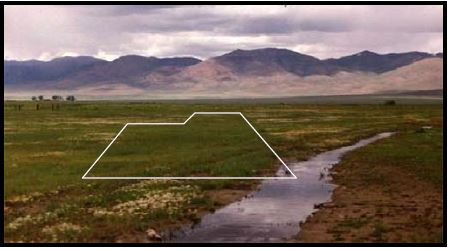
Interpretation of the results from Case Study 1 requires some caution. The absence of top growth one year after treatment indicates significant short-term control with Plateau®. This result strongly supports the interpretation that the shallow root system was eliminated, or largely so. The effect on deeper roots, however, is unknown. They may be alive or dead. If alive, sufficient time for new shoots to reach the surface may not have occurred. Follow-up monitoring in subsequent years is necessary to fully understand the extent of the short-term success of the initial treatment with Plateau®. The absence of hoary cress growth in 2004 does not indicate that follow-up treatment is unnecessary. Hoary cress seeds are in the soil and are likely to germinate during the next two to three years. These young plants will be easier to treat before they establish deep and widespread root systems.
Plateau® has a reported soil half-life of about 120 days. On plot 2, in 2003, there was insufficient precipitation to move the chemical from the soil surface (or residual left of leaves) or the dormant leaves into the root zone, until early to mid-November. Despite Plateau’s® reported trait of long soil persistence, the absence of any control of hoary cress on plot 2 (Figures 2a-2b) strongly suggests there was insufficient Plateau® in the root zone to kill the plants when growth resumed. Long exposure of the herbicide to sunlight (i.e., photo-degradation) before a significant precipitation event may be one reason. Another possibility is that cattle grazing on the site in July and August removed and degraded a critical amount of the active ingredient, when they consumed the leaves of the plant. Most of the Plateau® that was deposited on the plant leaves would not have been incorporated into the plant due to inactive growth. Foliage grazed by cattle must pass through their rumen. This process exposes the chemical to a large microbial population for several days or longer, and Plateau® is largely degraded by microbial decomposition. A persistent herbicide like Plateau®, which normally is moved into the soil after precipitation events, may become degraded and ineffective if the non-growing plants on which the herbicide resides are grazed before rainfall can move the chemical into the soil. Although speculative, this concept should be considered by herbicide applicators that apply soil-active chemicals.
Case Study 2 (Figures 5a-5c) indicates that Plateau® may be very effective for control of hoary cress when applied to fall regrowth in the rosette growth stage. The very high level of control observed on hoary cress was probably the result of both foliar uptake by actively growing rosettes and root uptake prior to plants becoming senescent. Rainfall shortly after application of the herbicide moved much of the chemical that resided on the soil surface into the root zone where uptake could occur.
The fall application of Plateau® also succeeded in controlling most of the Russian knapweed plants growing with the hoary cress (Special Publication 05-19). This suggests that Plateau® is an effective herbicide for locations where both species are present. Tordon®22K (picloram) is the herbicide usually used to treat Russian knapweed but it is not an effective control for hoary cress. Also, it is a restricted use chemical. Fall applications of Plateau® appear to effectively treat both hoary cress and Russian knapweed, and applicators are not required to be certified to use a restricted use herbicide. The selection of Plateau® for locations with both species may be very desirable when fall control programs are considered.
Despite promising results from the fall application of Plateau® on the basal rosettes of hoary cress, the results documented from Case Study 2 must be tempered with caution. This study was not replicated; therefore, other factors could have been responsible for the observed result. Additional case studies or treatment/control replicates must occur before this treatment can be recommended with a high degree of confidence.
Figures 5a-5c. These photos are from Case Study 2, the application of Plateau® on fall regrowth. Figure 5a shows the treated area on October 25, 2004 at the time Plateau® was applied. Figure 5b is representative of the level of herbicide coverage on basal rosettes of hoary cress and bare ground near these rosettes. Figure 5c is a repeat photo of Figure 5a, taken on June 28, 2005. Hoary cress is virtually absent in the treated area, but very abundant in the untreated area. The short, rosette plant in the untreated area is hoary cress and the taller herbaceous plant is Russian knapweed.
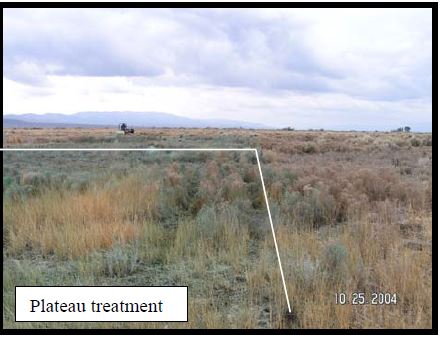
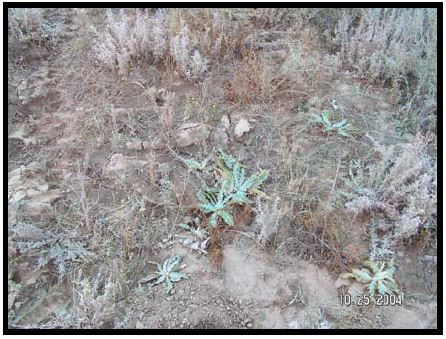
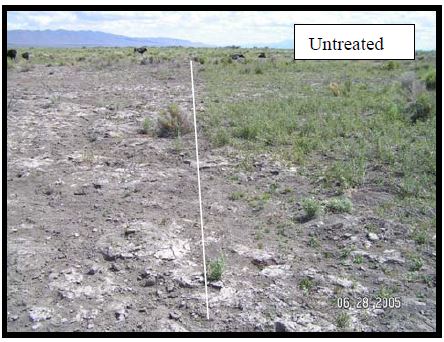
CONCLUSION
Plateau® herbicide has the potential to control hoary cress when applied at peak flowering or early post-flowering when soil moisture is adequate for continued growth of the plants. Application when soils are too dry to permit plant growth has poor treatment results. Also, Plateau® appears to provide excellent control of hoary cress on fall regrowth (rosettes). This result is probably due to uptake from both leaves and roots. A complete understanding about the short and long-term control provided from Plateau® will require several more years of monitoring.
BIBLIOGRAPHY
Anderson, W.P. 1999. Perennial Weeds: Characteristics and Identification of Selected Herbaceous Species. Iowa State University Press. Ames, Iowa. 228 pp.
BASF Corporation. Plateau® Specimen Label. Available at CDMS.
Ransom, C.V., C.A. Rice, and J.K. Ishida. 2001. Invasive Weed Control with Plateau® and Oasis®. Malheur Experiment Station. Oregon State University, Ontario, Oregon. Available at: Crop Info.
Schultz, B. W. 2005. Paradise Valley Weed Control Demonstration Plot: Russian Knapweed. University of Nevada Cooperative Extension Special Publication 05-19. 12 pp.
Sheley, R. and J. Stivers. 1999. Whitetop. Pages 401-407. In: R.L. Sheley and J.K. Petroff (eds). Biology and Management of Noxious Rangeland Weeds. Oregon State University Press. Corvallis, Oregon. 438 pp.
Vencill, W.K. (ed). 2002. Herbicide Handbook. Eighth Edition. Weed Science Society of America. Lawrence, Kansas. 493 pp.
Schultz, B.
2005,
Paradise Valley Weed Control Demonstration Plots: Hoary Cress,
University of Nevada Cooperative Extension


